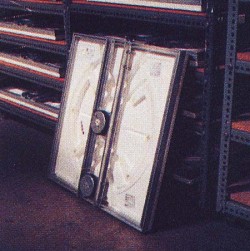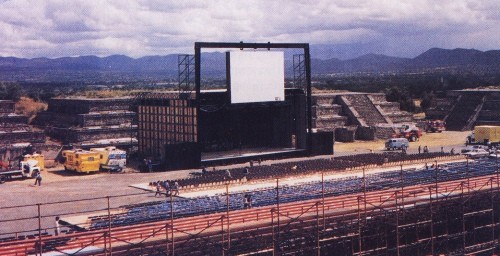Article about omnidirectional and half-omnidirectional (Lo-Q) loudspeaker systems in the Magazine LiveSound International July/August 1995
A Lo-Q System - The Ultimate Flat Loudspeaker
Most acoustical music instruments and most natural sources transmit sound with a very wide and consequently Lo-Q dispersion. Acoustically these are systems with a very low directivity index. In other words they are surrounded by their own sound. The sound spreads out into all directions without direction control in contrast to most modern (Hi-Q) speaker systems.
Status Q
In today's popular music it is accepted that the reinforced sound is somehow different from the original acoustical source. Even more often an acoustically produced sound isn't existing, instead the electrical signal is fed straight into the sound reinforcement system and the performance of the sound system is an important and audible part of the sound itself.
Many (most?) developments in sound reinforcement systems have been strongly influenced by today's popular music beginning with guitar amp speaker-sound and continuing through microphones, microphone techniques through to the common horn-derivative based sound system.
Today's high directivity-controlled systems are admittedly very efficient, especially when combined with the associated modern instrumentation. But as soon as this sound reinforcement status-quo is broken and reinforcement of "traditional" instruments is required, especially for the reinforcement of classical and jazz music not needing high SPL, the Hi-Q systems don't always meet audience expectations.
Hi-Q, Mid-Q, Lo-Q, Ultra-Lo-Q?
Historically horns, as the classic Hi-Q speaker, were the only way to get major SPL from the limited available power. So the development direction for speaker systems was somehow driven toward Hi-Q systems.
But like everything in nature, the more something is controlled the more it could become generally weak. And maybe for reinforcement of a sound with naturally wide dispersion a wide dispersion reinforcement system would/could create a more natural image.
Perhaps our ears and brains are more used to listening to a sound distribution with natural wide dispersion. In one of the basic characteristics, the directivity, modern reinforcement systems and natural acoustical sources are totally in conflict.
So the question arises, "What are sound reinforcement systems originally designed for?" It is given that only Hi-Q systems can successfully project sound for longer distances. And the very tight coverage of today's Mid-Q and Hi-Q systems has tremendous advantages in reaching the audience without transmitting too much sound into undesired directions.
And, as explained by the inverse square law, Lo-Q systems radiating sound into all directions offer good results only relative close to the loudspeaker itself because wide dispersion carrying of high power over a long distance is just impossible.
The Big A in Low-Q
The advantages of properly applied Lo-Q systems could be so important, that it is worth it to have a closer look at them. An established Lo-Q system already on the market are the planar speakers by "Sound Advance Systems, Inc." based in Santa Ana in California.

Until 1991 Sound Advance System was called B.E.S.T. Dr. Jose Bertagni, who passed away in 1992, started his developments in his native Argentina and founded B.E.S.T. in 1975 in Casta Mesa in California (B.E.S.T. stood for: Bertagni Electronic Sound Transducer International Corporation).
Because of his musical South American background, he didn't believe in the way regular speaker chassis sounded and started his own way to construct a loudspeaker which should have a highly uniform and wide distribution of the sound.
After years of exploration the right material was found. Polymer resins and polystyrene gave the possibility to build a loudspeaker as a very flat panel with the moving coil directly mounted onto it. The whole panel worked as the sound transducer. Very short movements versus a large moving area created the desired wide dispersion over the whole frequency range and so a very-Lo-Q speaker was developed.
An Evolution
During the following years the systems were improved and different versions manufactured. These loudspeakers are optimal for distributed sound systems like paging and background music installations. Compared with the Mid-Q or Hi-Q systems less individual speakers are needed by reaching a smoother coverage in mid/high frequencies. These flat panels are even paintable and thus nearly invisible in the right application.
One of the best-selling systems is the CT 77D, a loudspeaker in the shape of a 2 x 2 ceiling tile. The system doesn't only resemble a usual ceiling tile, it just is one, a self-sounding ceiling tile.
The CT 77D is a two-way system with a frequency response of 40Hz to 19kHz and a power handling of 120W RMS(EIA Standard RS-426A), the sensitivity is 94dB(1W/1m).
Because of the planar shape and the white color, the idea was hatched to assemble these flat speakers into a frame and create a screen. This way a video screen worked itself as a large speaker and by separating individual parts of the screen as a multi-channel speaker system.
But because of better response in the industry to their installations for background music and paging, the company established more contractor type business instaed of creating special sound reinforcement applications.
Then in 1988 the friendship between Dr. Bertagni and Placido Domingo forced the company to do the first big sound reinforcement job in Tehotihuacan, Mexico. This concert featured Placido Domingo, with three other soloists, a choir and symphonic orchestra for an audience of about 4,000 people.

Bigger, Better, Best
B.E.S.T. used 192 of their systems CT 72D combined to one huge screen atop the stage for sound reinforcement and video projection. The screen measured 32 x 24 ft. Sub-bass cabinets were additionally stacked on both sides of the stage.
Speaker segments of the screen were divided into eight vertical zones fed by an 8-channel mix out of the FOH (Yamaha PM3000) console. The engineering including all amps and surrounding equipment was done by the Los Angeles facility of the San Francisco-based McCune Audio.
Frank Supak, longtime head of the sound department at the Hollywood Bowl (CA) and one of the good old L.A. pros was the FOH mixing engineer. He was very familiar with these systems because he used them all the time at the Hollywood Bowl as distributed delay system.
He mixed the whole orchestra with the eight-channel mix like a projection from atop of the orchestra. Frank Supak: "So when you looked up to the screen and saw the large projection of the symphony orchestra, in real time you heard it in eight channels in stereo. And the system sounded very, very good".
Clear and natural sound was reached sans coloration or interference throughout the whole distribution angle. The illusion was created that the performing orchestra was playing beautifully loud and clear without reinforcement. And it wasn't possible to recognize, that the screen itself was a speaker system.
Only when the screen sound was turned off during the rehearsals was the difference obvious. Suddenly the orchestra level dropped significantly and the illusion disappeared.
Delayed Solutions
Frank recalled: ".. But the problem with the projection with Lo-Q was by going wide and not so deep". For that reason a delay line with regular speaker systems was installed underneath the audience risers.
These additional under-seat speakers with proper delaying and appropriate EQing were not realized by the audience but helped a lot to carry the sound to the farthest seats. Alejandro Bertagni from Sound Advance Systems (the son of the founder) recalled: "We reached an absolute even dispersion of the sound for more than 140 degrees. The audience in the farthest seats on the sides could hardly see but could hear everything in beautiful clarity."
All instrumental groups and the choir were separately miked, overhead or boundary on Plexiglas. Soloists' microphones were mounted on stands.
Now nearly seven years later, Frank Supak still describes this concert as an outstanding event. Especially the large very-Lo-Q sound screen with the eight sections created a unique natural sound of the orchestra. Frank said that also the delay line would have been created by B.E.S.T. planar speakers if they had some more over there. But the delay line was originally not planned.
For the one-day-show everything was carried from Los Angeles to Tehotihuacan (including drinking water) meaning very few spares were available.
Please visit the LiveSound International Magazine at www.livesoundint.com